Proposal for a Mobile Application Based Virtual Opal Card Enabled with NFC Technology
VerifiedAdded on 2023/06/05
|21
|4303
|362
AI Summary
This report proposes an innovative product development of a mobile application based virtual opal card enabled with NFC technology to address the problems with physical opal card. The report sheds light on several aspects like problem statement, background overview, strategic response, project option analysis and recommendations.
Contribute Materials
Your contribution can guide someone’s learning journey. Share your
documents today.

Business Case Title
Subtitle
Department Title
[This should be the publication title for the initiative,
if it were to be funded in the budget process.]
STRATEGIC ASSESSMENTSTRATEGIC ASSESSMENT
Subtitle
Department Title
[This should be the publication title for the initiative,
if it were to be funded in the budget process.]
STRATEGIC ASSESSMENTSTRATEGIC ASSESSMENT
Secure Best Marks with AI Grader
Need help grading? Try our AI Grader for instant feedback on your assignments.

Contents
Executive summary 1
1. Part 1 Problem 2
1.1 Background...................................................................................................2
1.2 Definition of the problem.............................................................................2
1.3 Evidence of the problem...............................................................................2
1.4 Timing considerations...................................................................................2
1.5 Consideration of the broader context............................................................3
2. Part 2 Benefits 4
2.1 Benefits to be delivered................................................................................4
2.2 Importance of the benefits to Government...................................................4
2.3 Evidence of benefit delivery.........................................................................4
2.4 Interdependencies.........................................................................................4
3. Part 3 Strategic response 5
3.1 Method and criteria.......................................................................................5
3.2 Strategic options analysis..............................................................................5
3.3 Recommended strategic option.....................................................................8
4. Part 4 Project options analysis 9
4.1 Project options considered............................................................................9
4.2 Stakeholder identification and consultation..................................................9
4.3 Social impacts.............................................................................................10
4.4 Environmental impacts...............................................................................10
4.5 Economic impacts.......................................................................................10
4.6 Overall evaluation of socio-economic and environmental impacts............10
4.7 Financial analysis........................................................................................11
4.8 Risk comparison.........................................................................................11
4.9 Integrated analysis and options ranking......................................................11
5. Part 5: Deliverability of recommended solution 14
5.1 Details of recommended solution...............................................................14
5.2 Commercial and financial...........................................................................14
5.3 Management................................................................................................17
5.4 Delivery......................................................................................................17
Appendix A: Benefit Management Plan 19
Appendix B: Financial data presentation 20
Appendix C: Sign-off checklist 22
Executive summary 1
1. Part 1 Problem 2
1.1 Background...................................................................................................2
1.2 Definition of the problem.............................................................................2
1.3 Evidence of the problem...............................................................................2
1.4 Timing considerations...................................................................................2
1.5 Consideration of the broader context............................................................3
2. Part 2 Benefits 4
2.1 Benefits to be delivered................................................................................4
2.2 Importance of the benefits to Government...................................................4
2.3 Evidence of benefit delivery.........................................................................4
2.4 Interdependencies.........................................................................................4
3. Part 3 Strategic response 5
3.1 Method and criteria.......................................................................................5
3.2 Strategic options analysis..............................................................................5
3.3 Recommended strategic option.....................................................................8
4. Part 4 Project options analysis 9
4.1 Project options considered............................................................................9
4.2 Stakeholder identification and consultation..................................................9
4.3 Social impacts.............................................................................................10
4.4 Environmental impacts...............................................................................10
4.5 Economic impacts.......................................................................................10
4.6 Overall evaluation of socio-economic and environmental impacts............10
4.7 Financial analysis........................................................................................11
4.8 Risk comparison.........................................................................................11
4.9 Integrated analysis and options ranking......................................................11
5. Part 5: Deliverability of recommended solution 14
5.1 Details of recommended solution...............................................................14
5.2 Commercial and financial...........................................................................14
5.3 Management................................................................................................17
5.4 Delivery......................................................................................................17
Appendix A: Benefit Management Plan 19
Appendix B: Financial data presentation 20
Appendix C: Sign-off checklist 22
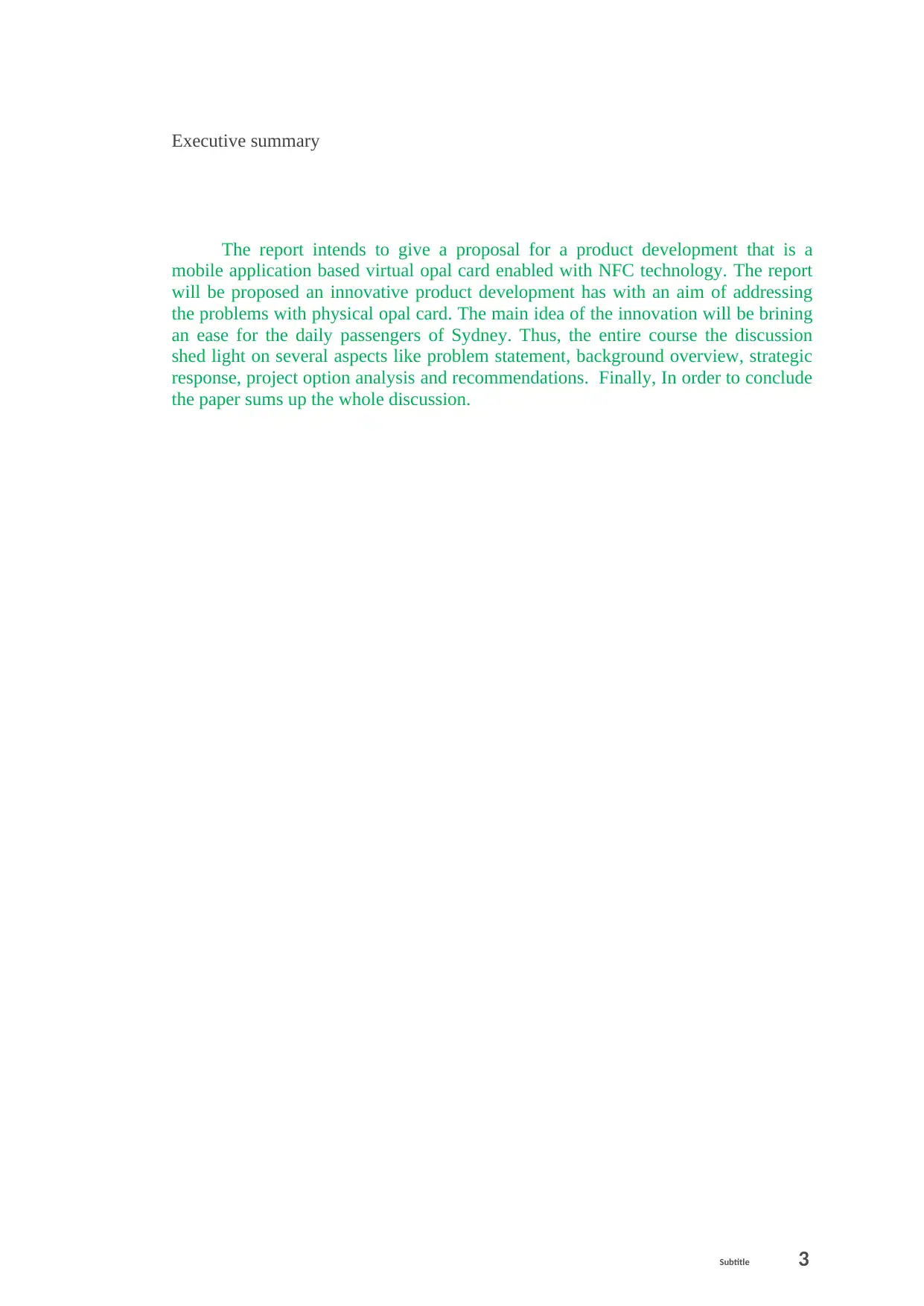
Executive summary
The report intends to give a proposal for a product development that is a
mobile application based virtual opal card enabled with NFC technology. The report
will be proposed an innovative product development has with an aim of addressing
the problems with physical opal card. The main idea of the innovation will be brining
an ease for the daily passengers of Sydney. Thus, the entire course the discussion
shed light on several aspects like problem statement, background overview, strategic
response, project option analysis and recommendations. Finally, In order to conclude
the paper sums up the whole discussion.
Subtitle 3
The report intends to give a proposal for a product development that is a
mobile application based virtual opal card enabled with NFC technology. The report
will be proposed an innovative product development has with an aim of addressing
the problems with physical opal card. The main idea of the innovation will be brining
an ease for the daily passengers of Sydney. Thus, the entire course the discussion
shed light on several aspects like problem statement, background overview, strategic
response, project option analysis and recommendations. Finally, In order to conclude
the paper sums up the whole discussion.
Subtitle 3
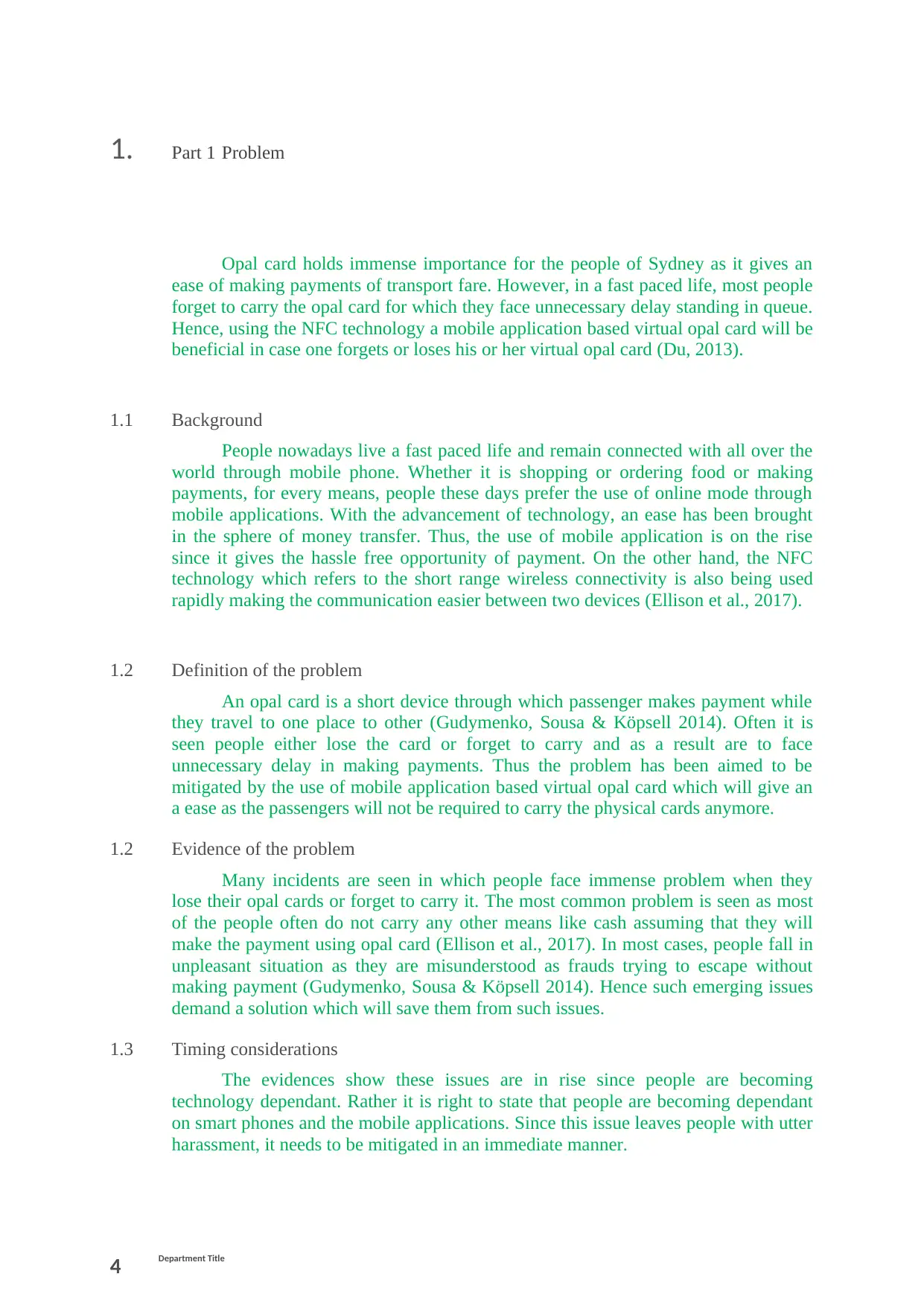
1. Part 1 Problem
Opal card holds immense importance for the people of Sydney as it gives an
ease of making payments of transport fare. However, in a fast paced life, most people
forget to carry the opal card for which they face unnecessary delay standing in queue.
Hence, using the NFC technology a mobile application based virtual opal card will be
beneficial in case one forgets or loses his or her virtual opal card (Du, 2013).
1.1 Background
People nowadays live a fast paced life and remain connected with all over the
world through mobile phone. Whether it is shopping or ordering food or making
payments, for every means, people these days prefer the use of online mode through
mobile applications. With the advancement of technology, an ease has been brought
in the sphere of money transfer. Thus, the use of mobile application is on the rise
since it gives the hassle free opportunity of payment. On the other hand, the NFC
technology which refers to the short range wireless connectivity is also being used
rapidly making the communication easier between two devices (Ellison et al., 2017).
1.2 Definition of the problem
An opal card is a short device through which passenger makes payment while
they travel to one place to other (Gudymenko, Sousa & Köpsell 2014). Often it is
seen people either lose the card or forget to carry and as a result are to face
unnecessary delay in making payments. Thus the problem has been aimed to be
mitigated by the use of mobile application based virtual opal card which will give an
a ease as the passengers will not be required to carry the physical cards anymore.
1.2 Evidence of the problem
Many incidents are seen in which people face immense problem when they
lose their opal cards or forget to carry it. The most common problem is seen as most
of the people often do not carry any other means like cash assuming that they will
make the payment using opal card (Ellison et al., 2017). In most cases, people fall in
unpleasant situation as they are misunderstood as frauds trying to escape without
making payment (Gudymenko, Sousa & Köpsell 2014). Hence such emerging issues
demand a solution which will save them from such issues.
1.3 Timing considerations
The evidences show these issues are in rise since people are becoming
technology dependant. Rather it is right to state that people are becoming dependant
on smart phones and the mobile applications. Since this issue leaves people with utter
harassment, it needs to be mitigated in an immediate manner.
4 Department Title
Opal card holds immense importance for the people of Sydney as it gives an
ease of making payments of transport fare. However, in a fast paced life, most people
forget to carry the opal card for which they face unnecessary delay standing in queue.
Hence, using the NFC technology a mobile application based virtual opal card will be
beneficial in case one forgets or loses his or her virtual opal card (Du, 2013).
1.1 Background
People nowadays live a fast paced life and remain connected with all over the
world through mobile phone. Whether it is shopping or ordering food or making
payments, for every means, people these days prefer the use of online mode through
mobile applications. With the advancement of technology, an ease has been brought
in the sphere of money transfer. Thus, the use of mobile application is on the rise
since it gives the hassle free opportunity of payment. On the other hand, the NFC
technology which refers to the short range wireless connectivity is also being used
rapidly making the communication easier between two devices (Ellison et al., 2017).
1.2 Definition of the problem
An opal card is a short device through which passenger makes payment while
they travel to one place to other (Gudymenko, Sousa & Köpsell 2014). Often it is
seen people either lose the card or forget to carry and as a result are to face
unnecessary delay in making payments. Thus the problem has been aimed to be
mitigated by the use of mobile application based virtual opal card which will give an
a ease as the passengers will not be required to carry the physical cards anymore.
1.2 Evidence of the problem
Many incidents are seen in which people face immense problem when they
lose their opal cards or forget to carry it. The most common problem is seen as most
of the people often do not carry any other means like cash assuming that they will
make the payment using opal card (Ellison et al., 2017). In most cases, people fall in
unpleasant situation as they are misunderstood as frauds trying to escape without
making payment (Gudymenko, Sousa & Köpsell 2014). Hence such emerging issues
demand a solution which will save them from such issues.
1.3 Timing considerations
The evidences show these issues are in rise since people are becoming
technology dependant. Rather it is right to state that people are becoming dependant
on smart phones and the mobile applications. Since this issue leaves people with utter
harassment, it needs to be mitigated in an immediate manner.
4 Department Title
Secure Best Marks with AI Grader
Need help grading? Try our AI Grader for instant feedback on your assignments.

1.4 Consideration of the broader context
There are very few mobile application is available for making payments easily.
However, there is no mobile application that serves an alternate to the physical opal
card. Hence, there is a scope of technological advancement which would serve
towards mitigating a major issue of business professionals to students.
Subtitle 5
There are very few mobile application is available for making payments easily.
However, there is no mobile application that serves an alternate to the physical opal
card. Hence, there is a scope of technological advancement which would serve
towards mitigating a major issue of business professionals to students.
Subtitle 5
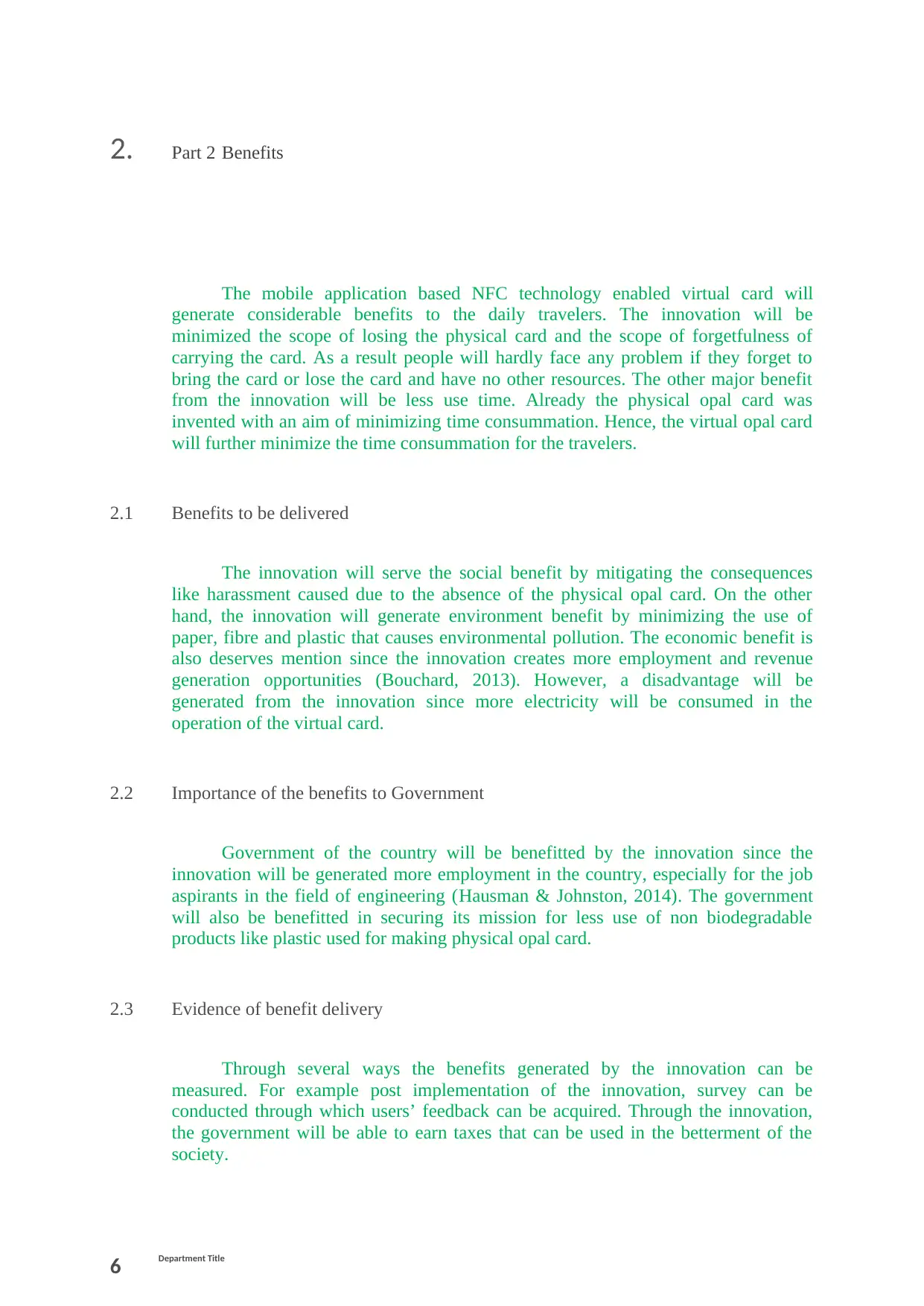
2. Part 2 Benefits
The mobile application based NFC technology enabled virtual card will
generate considerable benefits to the daily travelers. The innovation will be
minimized the scope of losing the physical card and the scope of forgetfulness of
carrying the card. As a result people will hardly face any problem if they forget to
bring the card or lose the card and have no other resources. The other major benefit
from the innovation will be less use time. Already the physical opal card was
invented with an aim of minimizing time consummation. Hence, the virtual opal card
will further minimize the time consummation for the travelers.
2.1 Benefits to be delivered
The innovation will serve the social benefit by mitigating the consequences
like harassment caused due to the absence of the physical opal card. On the other
hand, the innovation will generate environment benefit by minimizing the use of
paper, fibre and plastic that causes environmental pollution. The economic benefit is
also deserves mention since the innovation creates more employment and revenue
generation opportunities (Bouchard, 2013). However, a disadvantage will be
generated from the innovation since more electricity will be consumed in the
operation of the virtual card.
2.2 Importance of the benefits to Government
Government of the country will be benefitted by the innovation since the
innovation will be generated more employment in the country, especially for the job
aspirants in the field of engineering (Hausman & Johnston, 2014). The government
will also be benefitted in securing its mission for less use of non biodegradable
products like plastic used for making physical opal card.
2.3 Evidence of benefit delivery
Through several ways the benefits generated by the innovation can be
measured. For example post implementation of the innovation, survey can be
conducted through which users’ feedback can be acquired. Through the innovation,
the government will be able to earn taxes that can be used in the betterment of the
society.
6 Department Title
The mobile application based NFC technology enabled virtual card will
generate considerable benefits to the daily travelers. The innovation will be
minimized the scope of losing the physical card and the scope of forgetfulness of
carrying the card. As a result people will hardly face any problem if they forget to
bring the card or lose the card and have no other resources. The other major benefit
from the innovation will be less use time. Already the physical opal card was
invented with an aim of minimizing time consummation. Hence, the virtual opal card
will further minimize the time consummation for the travelers.
2.1 Benefits to be delivered
The innovation will serve the social benefit by mitigating the consequences
like harassment caused due to the absence of the physical opal card. On the other
hand, the innovation will generate environment benefit by minimizing the use of
paper, fibre and plastic that causes environmental pollution. The economic benefit is
also deserves mention since the innovation creates more employment and revenue
generation opportunities (Bouchard, 2013). However, a disadvantage will be
generated from the innovation since more electricity will be consumed in the
operation of the virtual card.
2.2 Importance of the benefits to Government
Government of the country will be benefitted by the innovation since the
innovation will be generated more employment in the country, especially for the job
aspirants in the field of engineering (Hausman & Johnston, 2014). The government
will also be benefitted in securing its mission for less use of non biodegradable
products like plastic used for making physical opal card.
2.3 Evidence of benefit delivery
Through several ways the benefits generated by the innovation can be
measured. For example post implementation of the innovation, survey can be
conducted through which users’ feedback can be acquired. Through the innovation,
the government will be able to earn taxes that can be used in the betterment of the
society.
6 Department Title

2.4 Interdependencies
The innovation will be dependent on the financial resources, the expertise of
the innovators and designers and appropriate marketing of the product so that more
people will be attracted to use the mobile application based virtual opal card (De
Medeiros, Ribeiro & Cortimiglia, 2014).
Subtitle 7
The innovation will be dependent on the financial resources, the expertise of
the innovators and designers and appropriate marketing of the product so that more
people will be attracted to use the mobile application based virtual opal card (De
Medeiros, Ribeiro & Cortimiglia, 2014).
Subtitle 7
Paraphrase This Document
Need a fresh take? Get an instant paraphrase of this document with our AI Paraphraser
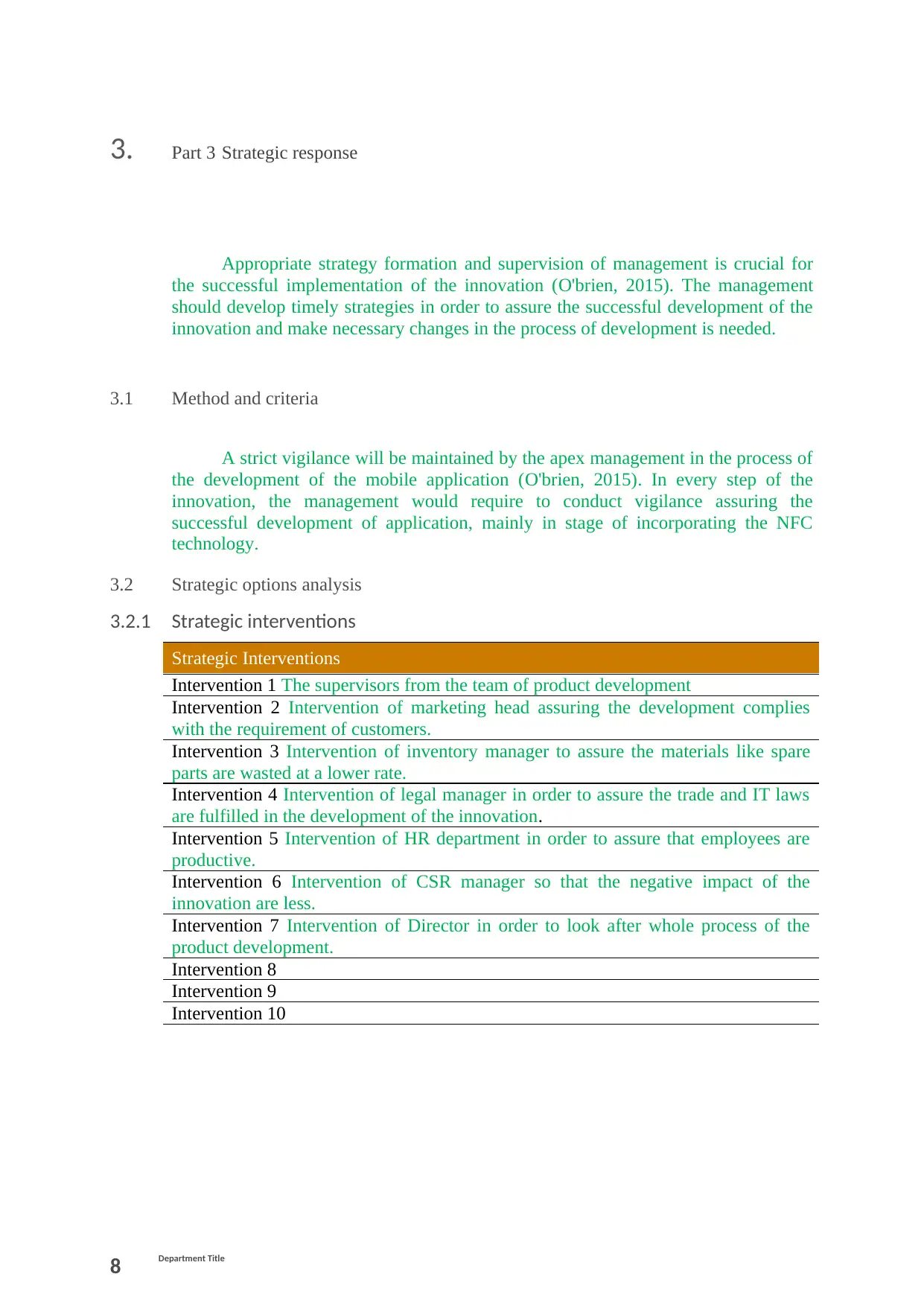
3. Part 3 Strategic response
Appropriate strategy formation and supervision of management is crucial for
the successful implementation of the innovation (O'brien, 2015). The management
should develop timely strategies in order to assure the successful development of the
innovation and make necessary changes in the process of development is needed.
3.1 Method and criteria
A strict vigilance will be maintained by the apex management in the process of
the development of the mobile application (O'brien, 2015). In every step of the
innovation, the management would require to conduct vigilance assuring the
successful development of application, mainly in stage of incorporating the NFC
technology.
3.2 Strategic options analysis
3.2.1 Strategic interventions
Strategic Interventions
Intervention 1 The supervisors from the team of product development
Intervention 2 Intervention of marketing head assuring the development complies
with the requirement of customers.
Intervention 3 Intervention of inventory manager to assure the materials like spare
parts are wasted at a lower rate.
Intervention 4 Intervention of legal manager in order to assure the trade and IT laws
are fulfilled in the development of the innovation.
Intervention 5 Intervention of HR department in order to assure that employees are
productive.
Intervention 6 Intervention of CSR manager so that the negative impact of the
innovation are less.
Intervention 7 Intervention of Director in order to look after whole process of the
product development.
Intervention 8
Intervention 9
Intervention 10
8 Department Title
Appropriate strategy formation and supervision of management is crucial for
the successful implementation of the innovation (O'brien, 2015). The management
should develop timely strategies in order to assure the successful development of the
innovation and make necessary changes in the process of development is needed.
3.1 Method and criteria
A strict vigilance will be maintained by the apex management in the process of
the development of the mobile application (O'brien, 2015). In every step of the
innovation, the management would require to conduct vigilance assuring the
successful development of application, mainly in stage of incorporating the NFC
technology.
3.2 Strategic options analysis
3.2.1 Strategic interventions
Strategic Interventions
Intervention 1 The supervisors from the team of product development
Intervention 2 Intervention of marketing head assuring the development complies
with the requirement of customers.
Intervention 3 Intervention of inventory manager to assure the materials like spare
parts are wasted at a lower rate.
Intervention 4 Intervention of legal manager in order to assure the trade and IT laws
are fulfilled in the development of the innovation.
Intervention 5 Intervention of HR department in order to assure that employees are
productive.
Intervention 6 Intervention of CSR manager so that the negative impact of the
innovation are less.
Intervention 7 Intervention of Director in order to look after whole process of the
product development.
Intervention 8
Intervention 9
Intervention 10
8 Department Title
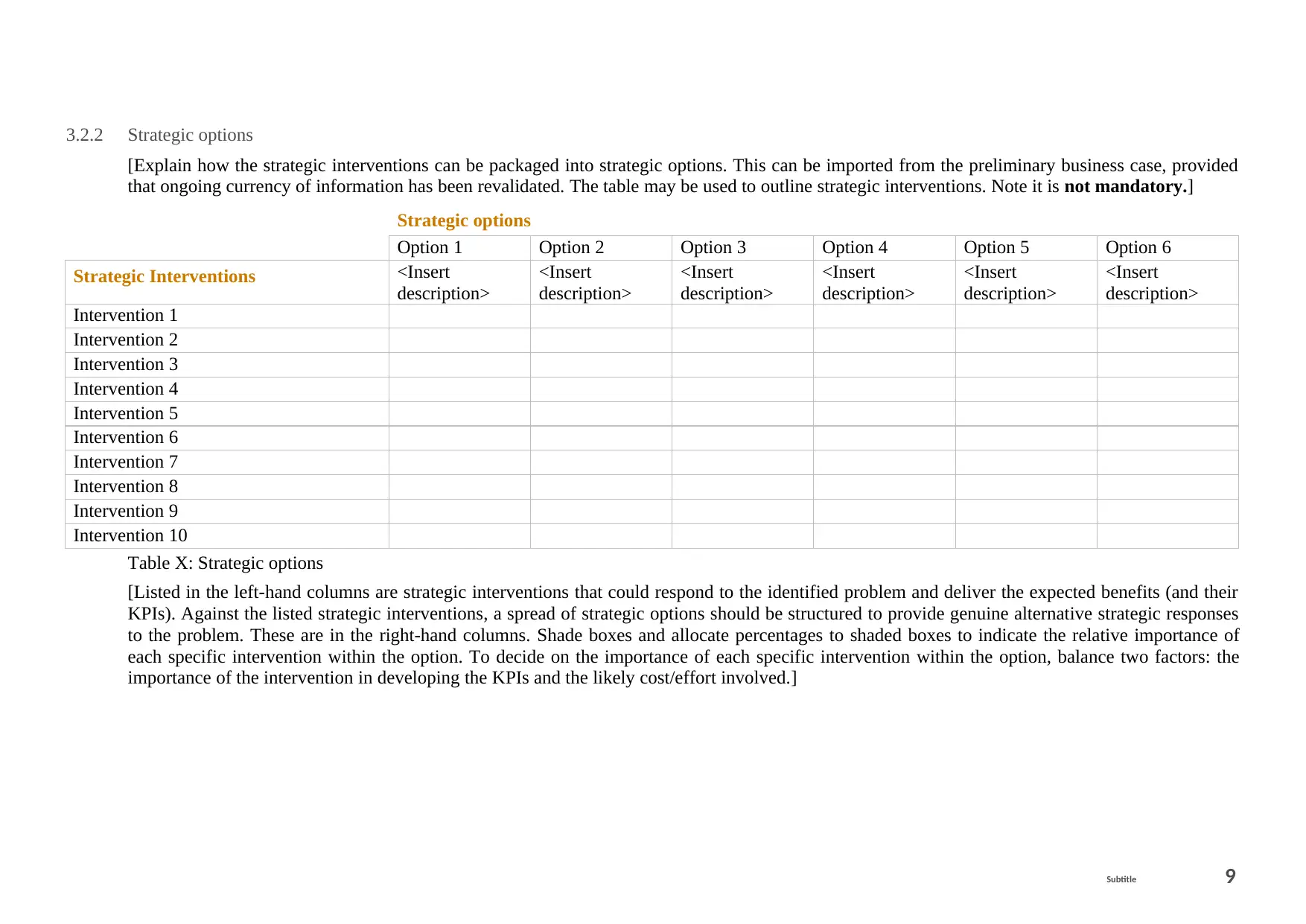
3.2.2 Strategic options
[Explain how the strategic interventions can be packaged into strategic options. This can be imported from the preliminary business case, provided
that ongoing currency of information has been revalidated. The table may be used to outline strategic interventions. Note it is not mandatory.]
Strategic options
Option 1 Option 2 Option 3 Option 4 Option 5 Option 6
Strategic Interventions <Insert
description>
<Insert
description>
<Insert
description>
<Insert
description>
<Insert
description>
<Insert
description>
Intervention 1
Intervention 2
Intervention 3
Intervention 4
Intervention 5
Intervention 6
Intervention 7
Intervention 8
Intervention 9
Intervention 10
Table X: Strategic options
[Listed in the left-hand columns are strategic interventions that could respond to the identified problem and deliver the expected benefits (and their
KPIs). Against the listed strategic interventions, a spread of strategic options should be structured to provide genuine alternative strategic responses
to the problem. These are in the right-hand columns. Shade boxes and allocate percentages to shaded boxes to indicate the relative importance of
each specific intervention within the option. To decide on the importance of each specific intervention within the option, balance two factors: the
importance of the intervention in developing the KPIs and the likely cost/effort involved.]
Subtitle 9
[Explain how the strategic interventions can be packaged into strategic options. This can be imported from the preliminary business case, provided
that ongoing currency of information has been revalidated. The table may be used to outline strategic interventions. Note it is not mandatory.]
Strategic options
Option 1 Option 2 Option 3 Option 4 Option 5 Option 6
Strategic Interventions <Insert
description>
<Insert
description>
<Insert
description>
<Insert
description>
<Insert
description>
<Insert
description>
Intervention 1
Intervention 2
Intervention 3
Intervention 4
Intervention 5
Intervention 6
Intervention 7
Intervention 8
Intervention 9
Intervention 10
Table X: Strategic options
[Listed in the left-hand columns are strategic interventions that could respond to the identified problem and deliver the expected benefits (and their
KPIs). Against the listed strategic interventions, a spread of strategic options should be structured to provide genuine alternative strategic responses
to the problem. These are in the right-hand columns. Shade boxes and allocate percentages to shaded boxes to indicate the relative importance of
each specific intervention within the option. To decide on the importance of each specific intervention within the option, balance two factors: the
importance of the intervention in developing the KPIs and the likely cost/effort involved.]
Subtitle 9
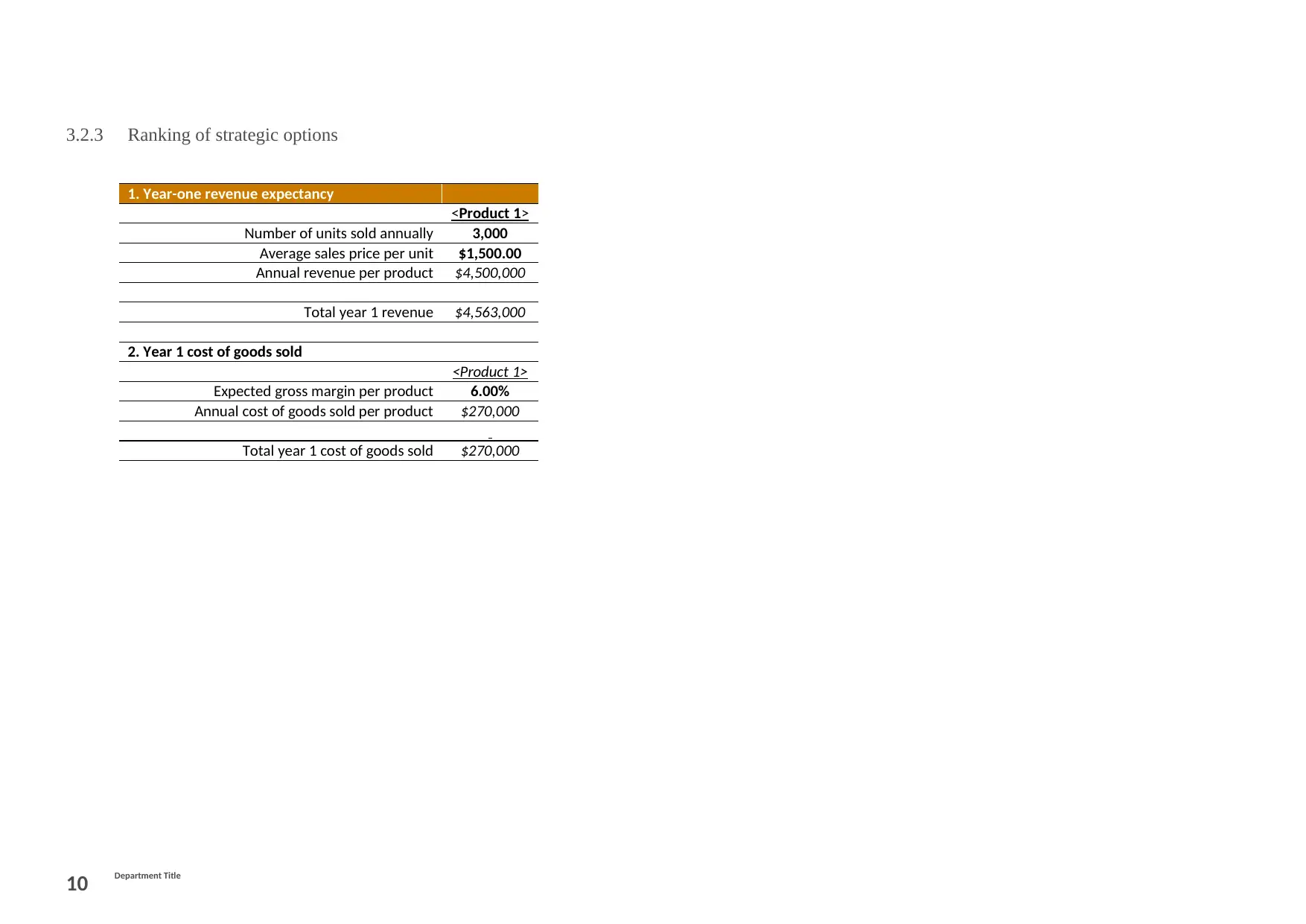
3.2.3 Ranking of strategic options
1. Year-one revenue expectancy
<Product 1>
Number of units sold annually 3,000
Average sales price per unit $1,500.00
Annual revenue per product $4,500,000
Total year 1 revenue $4,563,000
2. Year 1 cost of goods sold
<Product 1>
Expected gross margin per product 6.00%
Annual cost of goods sold per product $270,000
Total year 1 cost of goods sold $270,000
10 Department Title
1. Year-one revenue expectancy
<Product 1>
Number of units sold annually 3,000
Average sales price per unit $1,500.00
Annual revenue per product $4,500,000
Total year 1 revenue $4,563,000
2. Year 1 cost of goods sold
<Product 1>
Expected gross margin per product 6.00%
Annual cost of goods sold per product $270,000
Total year 1 cost of goods sold $270,000
10 Department Title
Secure Best Marks with AI Grader
Need help grading? Try our AI Grader for instant feedback on your assignments.
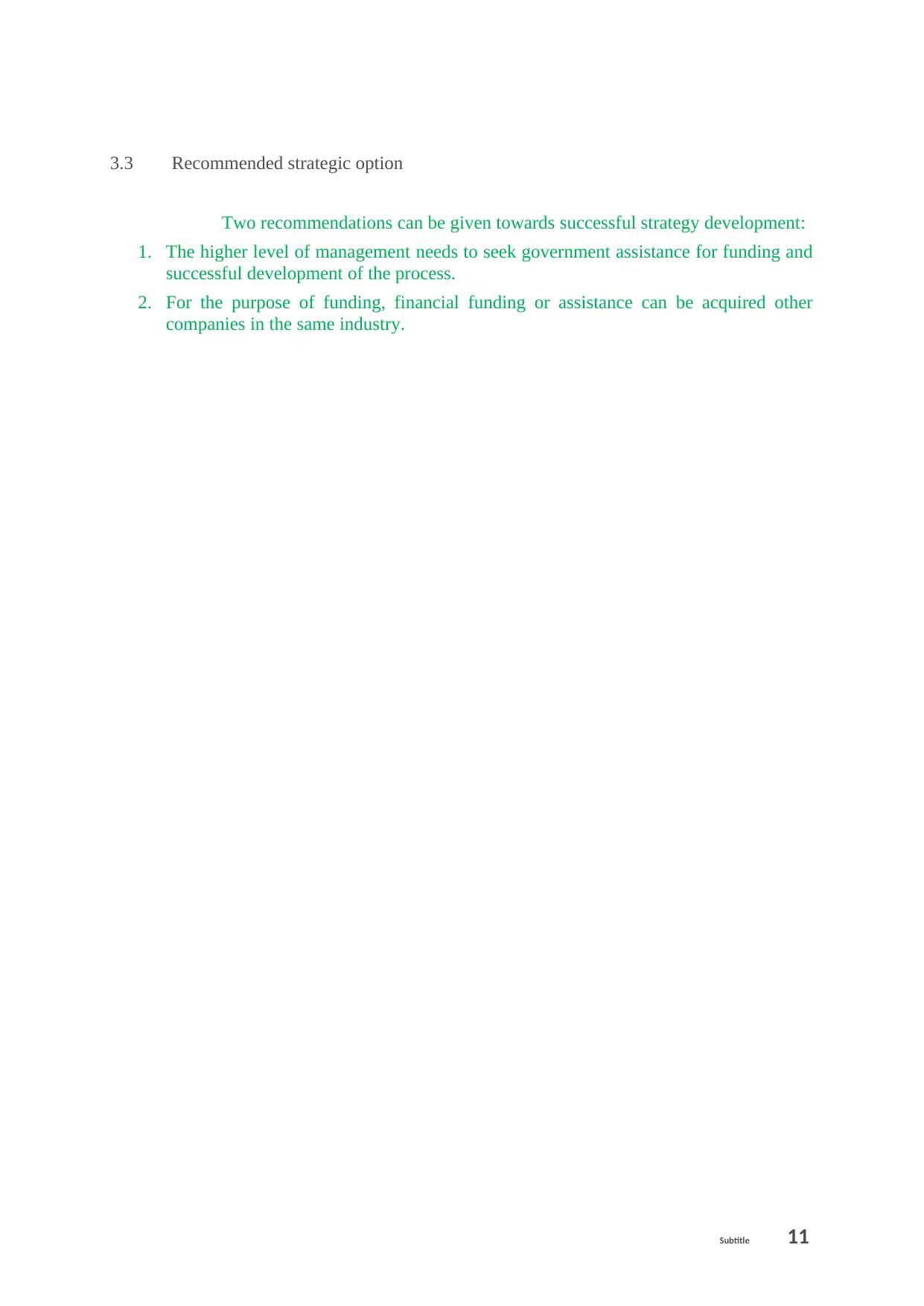
3.3 Recommended strategic option
Two recommendations can be given towards successful strategy development:
1. The higher level of management needs to seek government assistance for funding and
successful development of the process.
2. For the purpose of funding, financial funding or assistance can be acquired other
companies in the same industry.
Subtitle 11
Two recommendations can be given towards successful strategy development:
1. The higher level of management needs to seek government assistance for funding and
successful development of the process.
2. For the purpose of funding, financial funding or assistance can be acquired other
companies in the same industry.
Subtitle 11
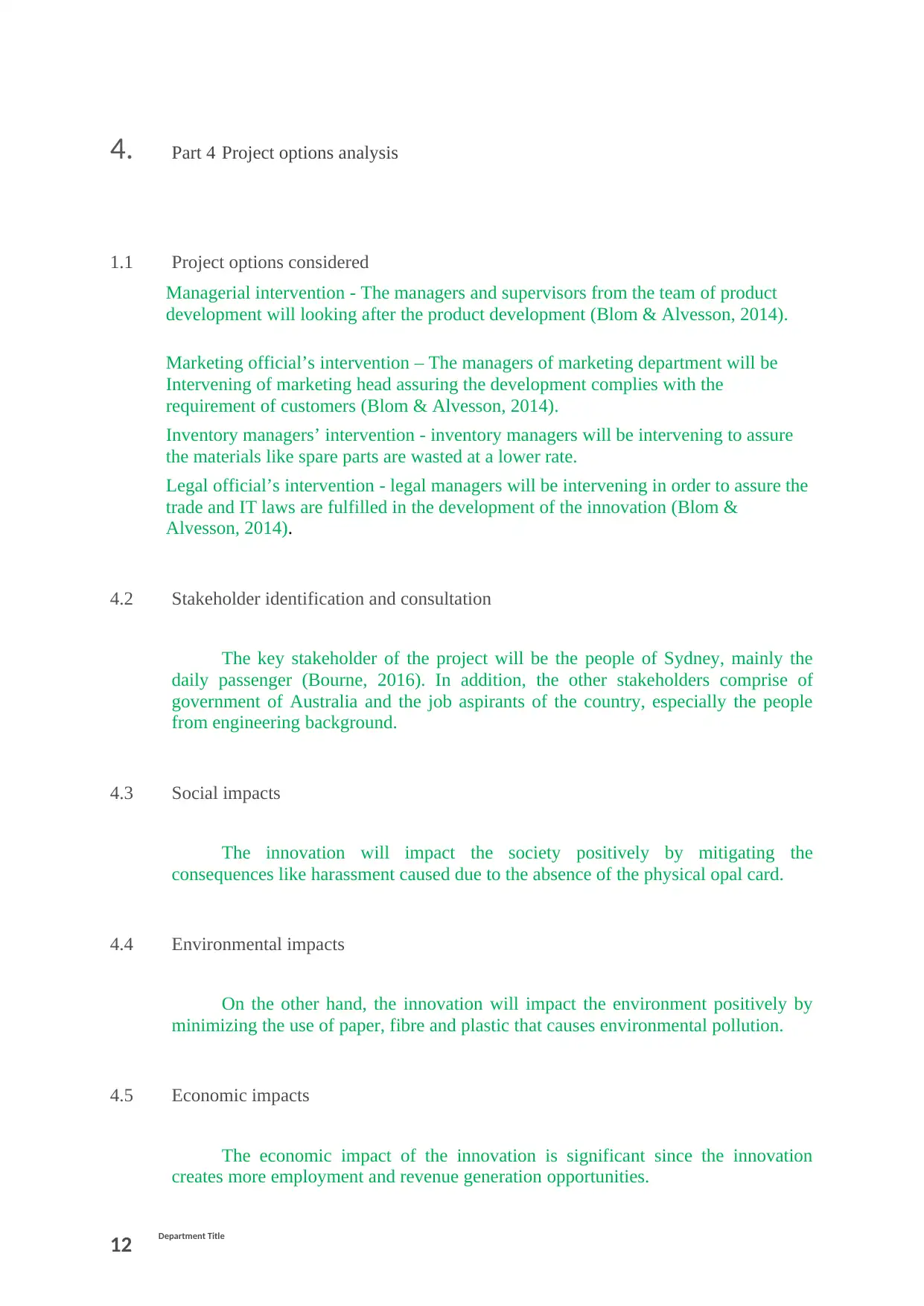
4. Part 4 Project options analysis
1.1 Project options considered
Managerial intervention - The managers and supervisors from the team of product
development will looking after the product development (Blom & Alvesson, 2014).
Marketing official’s intervention – The managers of marketing department will be
Intervening of marketing head assuring the development complies with the
requirement of customers (Blom & Alvesson, 2014).
Inventory managers’ intervention - inventory managers will be intervening to assure
the materials like spare parts are wasted at a lower rate.
Legal official’s intervention - legal managers will be intervening in order to assure the
trade and IT laws are fulfilled in the development of the innovation (Blom &
Alvesson, 2014).
4.2 Stakeholder identification and consultation
The key stakeholder of the project will be the people of Sydney, mainly the
daily passenger (Bourne, 2016). In addition, the other stakeholders comprise of
government of Australia and the job aspirants of the country, especially the people
from engineering background.
4.3 Social impacts
The innovation will impact the society positively by mitigating the
consequences like harassment caused due to the absence of the physical opal card.
4.4 Environmental impacts
On the other hand, the innovation will impact the environment positively by
minimizing the use of paper, fibre and plastic that causes environmental pollution.
4.5 Economic impacts
The economic impact of the innovation is significant since the innovation
creates more employment and revenue generation opportunities.
12 Department Title
1.1 Project options considered
Managerial intervention - The managers and supervisors from the team of product
development will looking after the product development (Blom & Alvesson, 2014).
Marketing official’s intervention – The managers of marketing department will be
Intervening of marketing head assuring the development complies with the
requirement of customers (Blom & Alvesson, 2014).
Inventory managers’ intervention - inventory managers will be intervening to assure
the materials like spare parts are wasted at a lower rate.
Legal official’s intervention - legal managers will be intervening in order to assure the
trade and IT laws are fulfilled in the development of the innovation (Blom &
Alvesson, 2014).
4.2 Stakeholder identification and consultation
The key stakeholder of the project will be the people of Sydney, mainly the
daily passenger (Bourne, 2016). In addition, the other stakeholders comprise of
government of Australia and the job aspirants of the country, especially the people
from engineering background.
4.3 Social impacts
The innovation will impact the society positively by mitigating the
consequences like harassment caused due to the absence of the physical opal card.
4.4 Environmental impacts
On the other hand, the innovation will impact the environment positively by
minimizing the use of paper, fibre and plastic that causes environmental pollution.
4.5 Economic impacts
The economic impact of the innovation is significant since the innovation
creates more employment and revenue generation opportunities.
12 Department Title
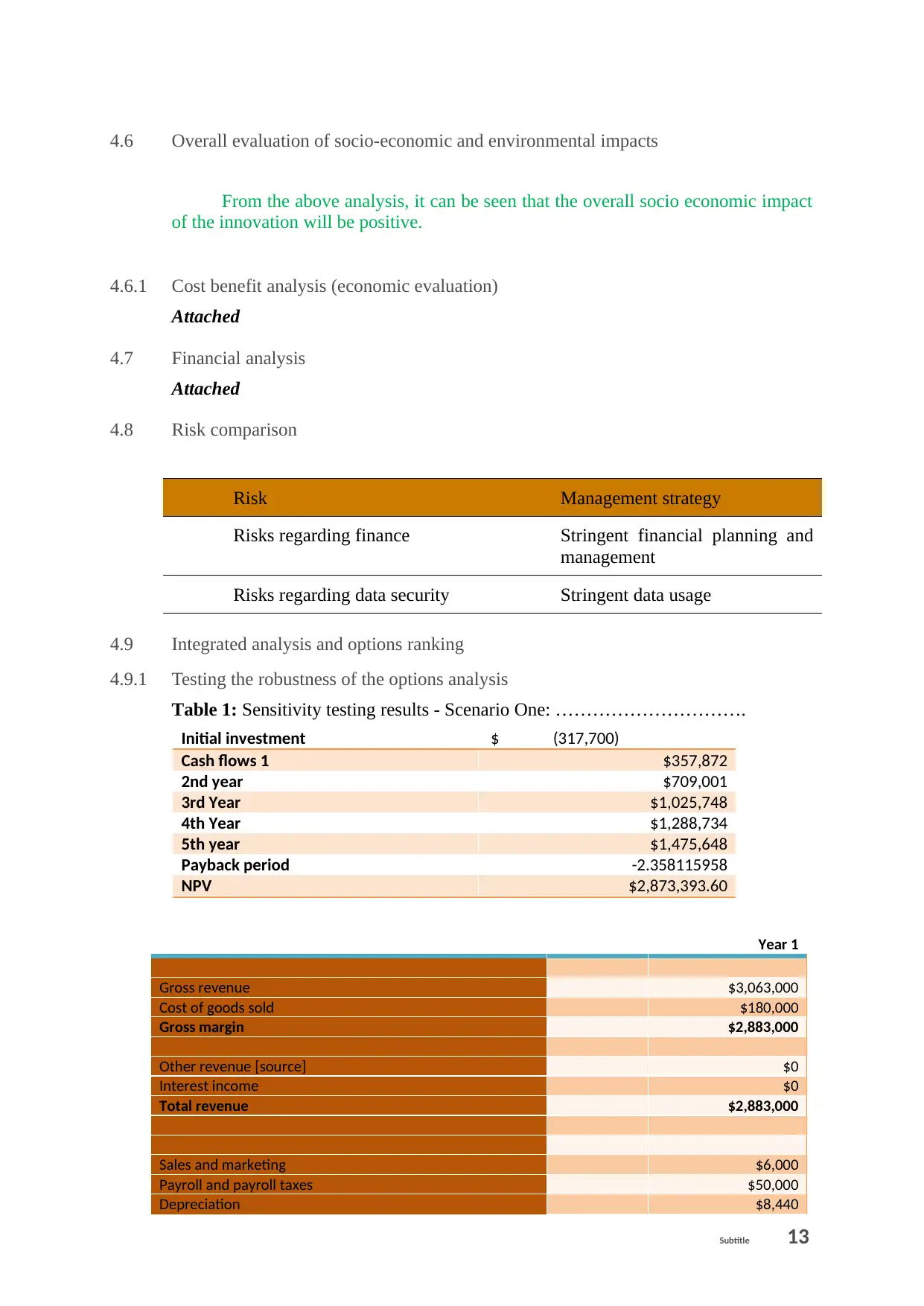
4.6 Overall evaluation of socio-economic and environmental impacts
From the above analysis, it can be seen that the overall socio economic impact
of the innovation will be positive.
4.6.1 Cost benefit analysis (economic evaluation)
Attached
4.7 Financial analysis
Attached
4.8 Risk comparison
Risk Management strategy
Risks regarding finance Stringent financial planning and
management
Risks regarding data security Stringent data usage
4.9 Integrated analysis and options ranking
4.9.1 Testing the robustness of the options analysis
Table 1: Sensitivity testing results - Scenario One: ………………………….
Initial investment $ (317,700)
Cash flows 1 $357,872
2nd year $709,001
3rd Year $1,025,748
4th Year $1,288,734
5th year $1,475,648
Payback period -2.358115958
NPV $2,873,393.60
Year 1
Gross revenue $3,063,000
Cost of goods sold $180,000
Gross margin $2,883,000
Other revenue [source] $0
Interest income $0
Total revenue $2,883,000
Sales and marketing $6,000
Payroll and payroll taxes $50,000
Depreciation $8,440
Subtitle 13
From the above analysis, it can be seen that the overall socio economic impact
of the innovation will be positive.
4.6.1 Cost benefit analysis (economic evaluation)
Attached
4.7 Financial analysis
Attached
4.8 Risk comparison
Risk Management strategy
Risks regarding finance Stringent financial planning and
management
Risks regarding data security Stringent data usage
4.9 Integrated analysis and options ranking
4.9.1 Testing the robustness of the options analysis
Table 1: Sensitivity testing results - Scenario One: ………………………….
Initial investment $ (317,700)
Cash flows 1 $357,872
2nd year $709,001
3rd Year $1,025,748
4th Year $1,288,734
5th year $1,475,648
Payback period -2.358115958
NPV $2,873,393.60
Year 1
Gross revenue $3,063,000
Cost of goods sold $180,000
Gross margin $2,883,000
Other revenue [source] $0
Interest income $0
Total revenue $2,883,000
Sales and marketing $6,000
Payroll and payroll taxes $50,000
Depreciation $8,440
Subtitle 13
Paraphrase This Document
Need a fresh take? Get an instant paraphrase of this document with our AI Paraphraser
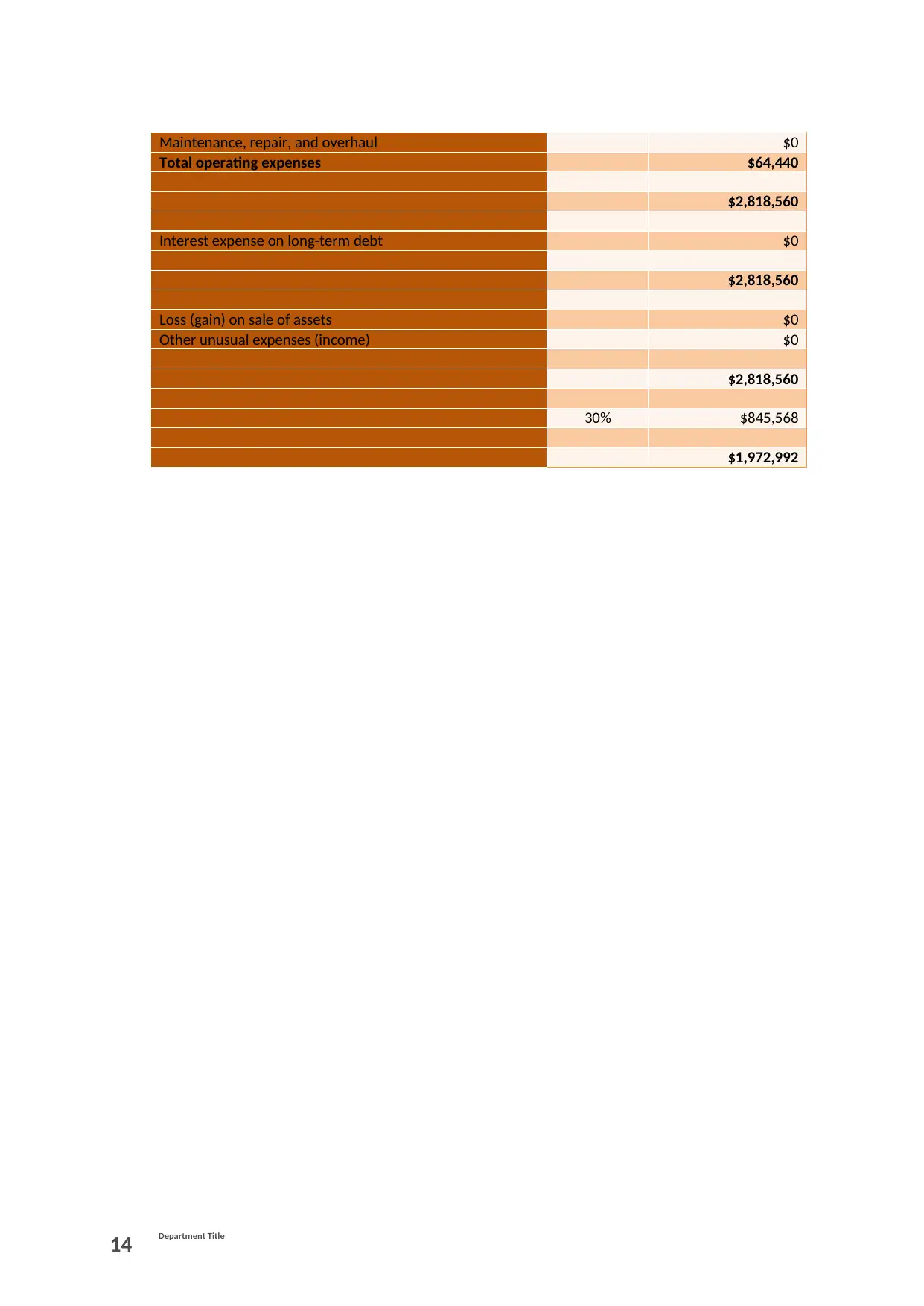
Maintenance, repair, and overhaul $0
Total operating expenses $64,440
$2,818,560
Interest expense on long-term debt $0
$2,818,560
Loss (gain) on sale of assets $0
Other unusual expenses (income) $0
$2,818,560
30% $845,568
$1,972,992
14 Department Title
Total operating expenses $64,440
$2,818,560
Interest expense on long-term debt $0
$2,818,560
Loss (gain) on sale of assets $0
Other unusual expenses (income) $0
$2,818,560
30% $845,568
$1,972,992
14 Department Title
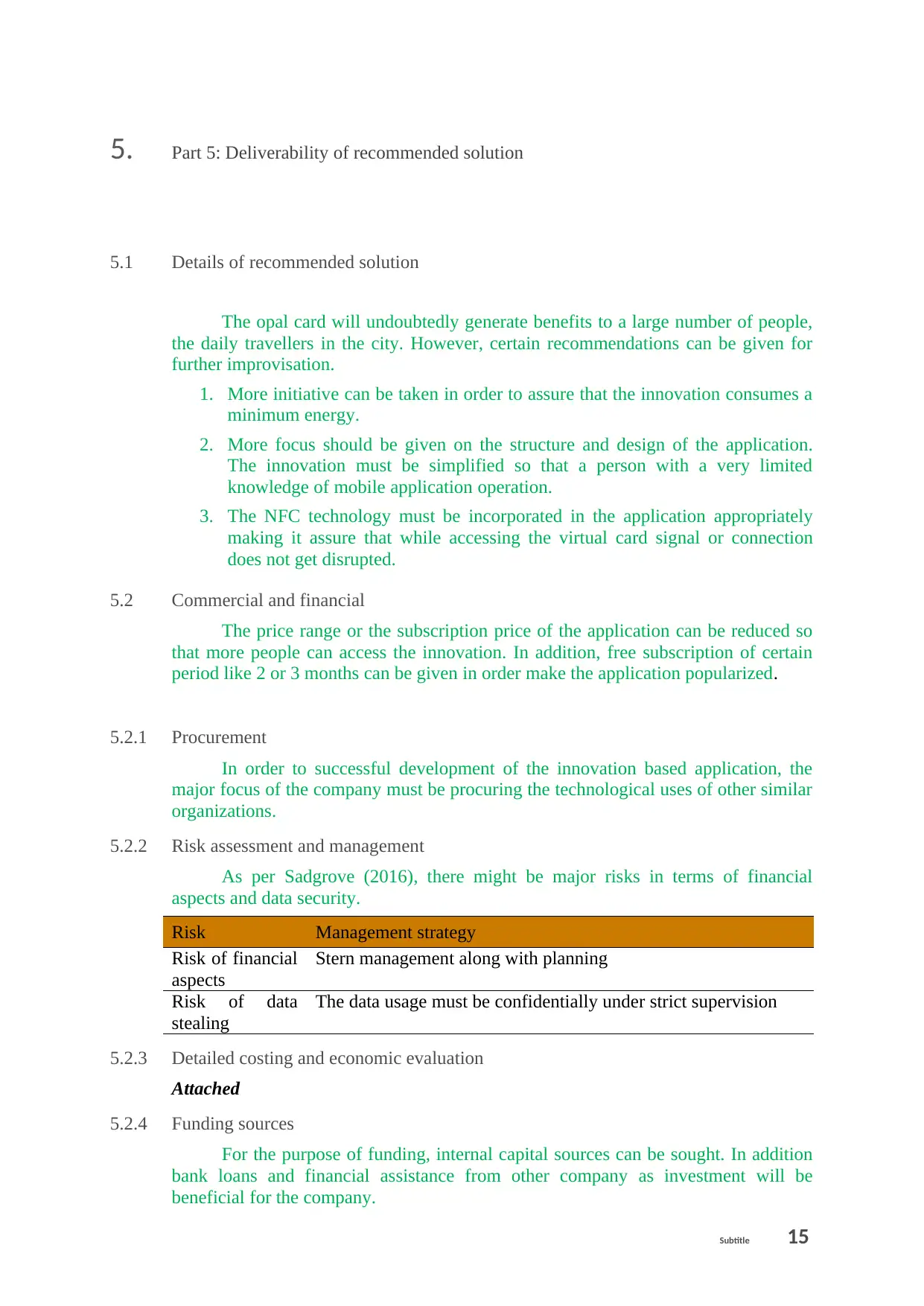
5. Part 5: Deliverability of recommended solution
5.1 Details of recommended solution
The opal card will undoubtedly generate benefits to a large number of people,
the daily travellers in the city. However, certain recommendations can be given for
further improvisation.
1. More initiative can be taken in order to assure that the innovation consumes a
minimum energy.
2. More focus should be given on the structure and design of the application.
The innovation must be simplified so that a person with a very limited
knowledge of mobile application operation.
3. The NFC technology must be incorporated in the application appropriately
making it assure that while accessing the virtual card signal or connection
does not get disrupted.
5.2 Commercial and financial
The price range or the subscription price of the application can be reduced so
that more people can access the innovation. In addition, free subscription of certain
period like 2 or 3 months can be given in order make the application popularized.
5.2.1 Procurement
In order to successful development of the innovation based application, the
major focus of the company must be procuring the technological uses of other similar
organizations.
5.2.2 Risk assessment and management
As per Sadgrove (2016), there might be major risks in terms of financial
aspects and data security.
Risk Management strategy
Risk of financial
aspects
Stern management along with planning
Risk of data
stealing
The data usage must be confidentially under strict supervision
5.2.3 Detailed costing and economic evaluation
Attached
5.2.4 Funding sources
For the purpose of funding, internal capital sources can be sought. In addition
bank loans and financial assistance from other company as investment will be
beneficial for the company.
Subtitle 15
5.1 Details of recommended solution
The opal card will undoubtedly generate benefits to a large number of people,
the daily travellers in the city. However, certain recommendations can be given for
further improvisation.
1. More initiative can be taken in order to assure that the innovation consumes a
minimum energy.
2. More focus should be given on the structure and design of the application.
The innovation must be simplified so that a person with a very limited
knowledge of mobile application operation.
3. The NFC technology must be incorporated in the application appropriately
making it assure that while accessing the virtual card signal or connection
does not get disrupted.
5.2 Commercial and financial
The price range or the subscription price of the application can be reduced so
that more people can access the innovation. In addition, free subscription of certain
period like 2 or 3 months can be given in order make the application popularized.
5.2.1 Procurement
In order to successful development of the innovation based application, the
major focus of the company must be procuring the technological uses of other similar
organizations.
5.2.2 Risk assessment and management
As per Sadgrove (2016), there might be major risks in terms of financial
aspects and data security.
Risk Management strategy
Risk of financial
aspects
Stern management along with planning
Risk of data
stealing
The data usage must be confidentially under strict supervision
5.2.3 Detailed costing and economic evaluation
Attached
5.2.4 Funding sources
For the purpose of funding, internal capital sources can be sought. In addition
bank loans and financial assistance from other company as investment will be
beneficial for the company.
Subtitle 15
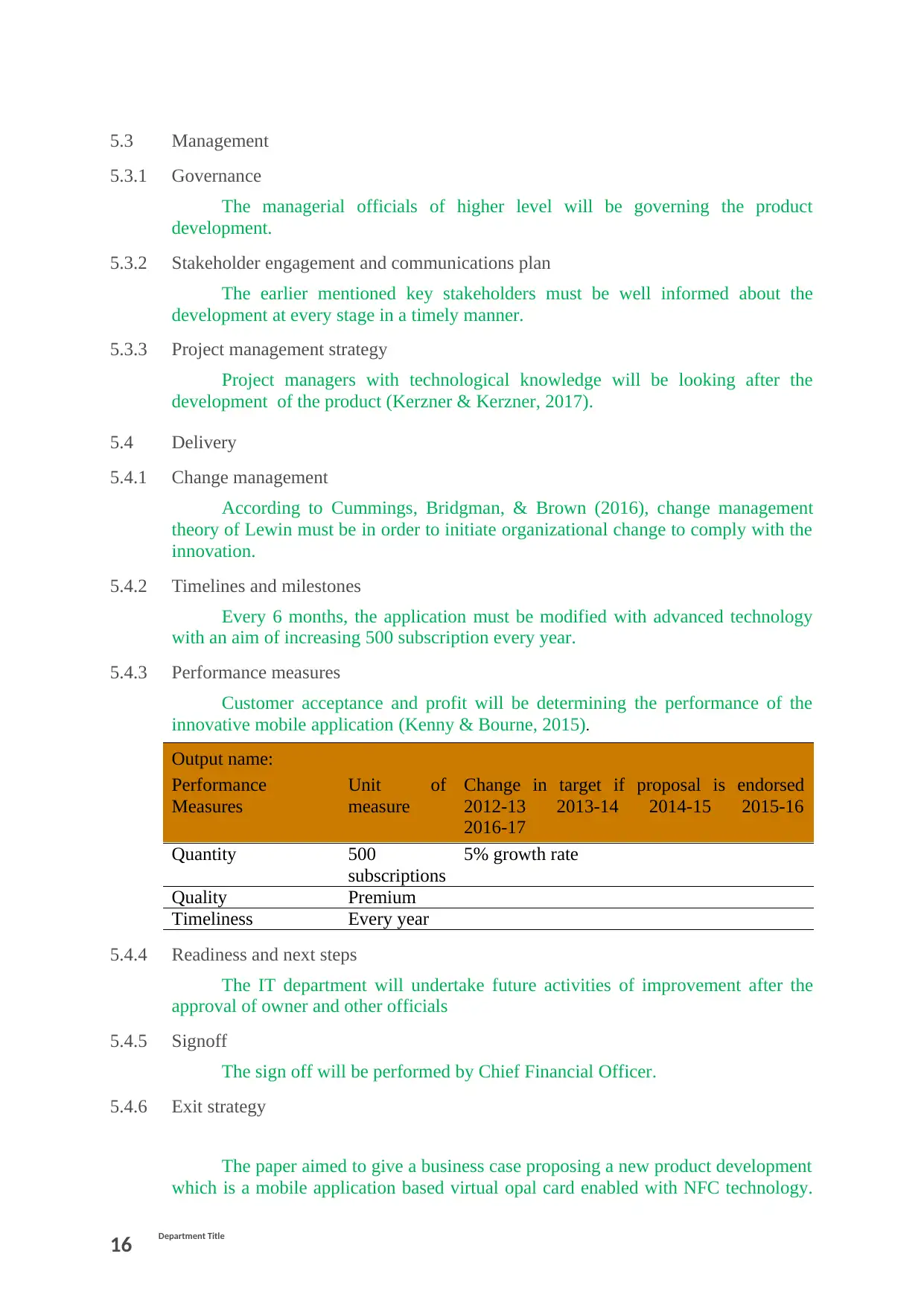
5.3 Management
5.3.1 Governance
The managerial officials of higher level will be governing the product
development.
5.3.2 Stakeholder engagement and communications plan
The earlier mentioned key stakeholders must be well informed about the
development at every stage in a timely manner.
5.3.3 Project management strategy
Project managers with technological knowledge will be looking after the
development of the product (Kerzner & Kerzner, 2017).
5.4 Delivery
5.4.1 Change management
According to Cummings, Bridgman, & Brown (2016), change management
theory of Lewin must be in order to initiate organizational change to comply with the
innovation.
5.4.2 Timelines and milestones
Every 6 months, the application must be modified with advanced technology
with an aim of increasing 500 subscription every year.
5.4.3 Performance measures
Customer acceptance and profit will be determining the performance of the
innovative mobile application (Kenny & Bourne, 2015).
Output name:
Performance
Measures
Unit of
measure
Change in target if proposal is endorsed
2012-13 2013-14 2014-15 2015-16
2016-17
Quantity 500
subscriptions
5% growth rate
Quality Premium
Timeliness Every year
5.4.4 Readiness and next steps
The IT department will undertake future activities of improvement after the
approval of owner and other officials
5.4.5 Signoff
The sign off will be performed by Chief Financial Officer.
5.4.6 Exit strategy
The paper aimed to give a business case proposing a new product development
which is a mobile application based virtual opal card enabled with NFC technology.
16 Department Title
5.3.1 Governance
The managerial officials of higher level will be governing the product
development.
5.3.2 Stakeholder engagement and communications plan
The earlier mentioned key stakeholders must be well informed about the
development at every stage in a timely manner.
5.3.3 Project management strategy
Project managers with technological knowledge will be looking after the
development of the product (Kerzner & Kerzner, 2017).
5.4 Delivery
5.4.1 Change management
According to Cummings, Bridgman, & Brown (2016), change management
theory of Lewin must be in order to initiate organizational change to comply with the
innovation.
5.4.2 Timelines and milestones
Every 6 months, the application must be modified with advanced technology
with an aim of increasing 500 subscription every year.
5.4.3 Performance measures
Customer acceptance and profit will be determining the performance of the
innovative mobile application (Kenny & Bourne, 2015).
Output name:
Performance
Measures
Unit of
measure
Change in target if proposal is endorsed
2012-13 2013-14 2014-15 2015-16
2016-17
Quantity 500
subscriptions
5% growth rate
Quality Premium
Timeliness Every year
5.4.4 Readiness and next steps
The IT department will undertake future activities of improvement after the
approval of owner and other officials
5.4.5 Signoff
The sign off will be performed by Chief Financial Officer.
5.4.6 Exit strategy
The paper aimed to give a business case proposing a new product development
which is a mobile application based virtual opal card enabled with NFC technology.
16 Department Title
Secure Best Marks with AI Grader
Need help grading? Try our AI Grader for instant feedback on your assignments.

The innovative product development has been proposed with an aim of mitigating the
issues with physical card. On the other hand, the main idea of the innovation is to
bring an ease for the daily passengers of Sydney. Hence the whole course the
discussion threw light on several aspects like problem statement, background
overview, strategic response, project option analysis and recommendations. Hence, it
can be said that the paper tried to cover all the aspects in relation with proposing an
innovation.
Subtitle 17
issues with physical card. On the other hand, the main idea of the innovation is to
bring an ease for the daily passengers of Sydney. Hence the whole course the
discussion threw light on several aspects like problem statement, background
overview, strategic response, project option analysis and recommendations. Hence, it
can be said that the paper tried to cover all the aspects in relation with proposing an
innovation.
Subtitle 17

Appendix A: Benefit Management Plan
With
downsizing
Without
Appraisal period (years) 10 10
Capital Costs $0 $2,000,000
Whole of Life Costs $675,000 $17,000,00
Cost-benefit analysis of monetary costs and benefits at the Public Sector
Discount Rate
Present Value of Benefits $414,935 $7,604,631
Present Value of Costs $550,233 $7,849,716
Benefit Cost Ratio 0.75 0.97
Net Present Value -$135,299 -$245,085
18 Department Title
With
downsizing
Without
Appraisal period (years) 10 10
Capital Costs $0 $2,000,000
Whole of Life Costs $675,000 $17,000,00
Cost-benefit analysis of monetary costs and benefits at the Public Sector
Discount Rate
Present Value of Benefits $414,935 $7,604,631
Present Value of Costs $550,233 $7,849,716
Benefit Cost Ratio 0.75 0.97
Net Present Value -$135,299 -$245,085
18 Department Title
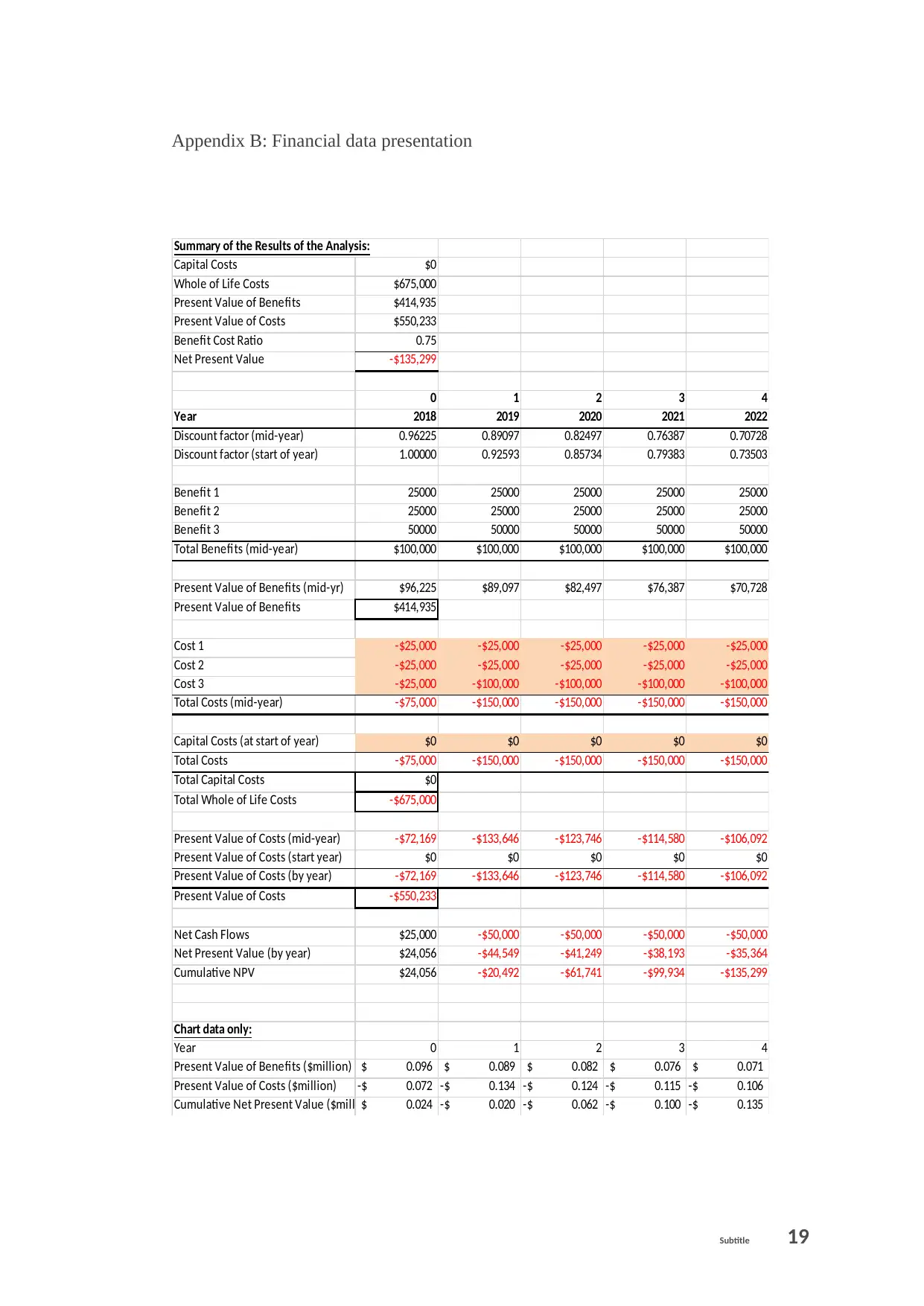
Appendix B: Financial data presentation
Summary of the Results of the Analysis:
Capital Costs $0
Whole of Life Costs $675,000
Present Value of Benefits $414,935
Present Value of Costs $550,233
Benefit Cost Ratio 0.75
Net Present Value -$135,299
0 1 2 3 4
Year 2018 2019 2020 2021 2022
Discount factor (mid-year) 0.96225 0.89097 0.82497 0.76387 0.70728
Discount factor (start of year) 1.00000 0.92593 0.85734 0.79383 0.73503
Benefit 1 25000 25000 25000 25000 25000
Benefit 2 25000 25000 25000 25000 25000
Benefit 3 50000 50000 50000 50000 50000
Total Benefits (mid-year) $100,000 $100,000 $100,000 $100,000 $100,000
Present Value of Benefits (mid-yr) $96,225 $89,097 $82,497 $76,387 $70,728
Present Value of Benefits $414,935
Cost 1 -$25,000 -$25,000 -$25,000 -$25,000 -$25,000
Cost 2 -$25,000 -$25,000 -$25,000 -$25,000 -$25,000
Cost 3 -$25,000 -$100,000 -$100,000 -$100,000 -$100,000
Total Costs (mid-year) -$75,000 -$150,000 -$150,000 -$150,000 -$150,000
Capital Costs (at start of year) $0 $0 $0 $0 $0
Total Costs -$75,000 -$150,000 -$150,000 -$150,000 -$150,000
Total Capital Costs $0
Total Whole of Life Costs -$675,000
Present Value of Costs (mid-year) -$72,169 -$133,646 -$123,746 -$114,580 -$106,092
Present Value of Costs (start year) $0 $0 $0 $0 $0
Present Value of Costs (by year) -$72,169 -$133,646 -$123,746 -$114,580 -$106,092
Present Value of Costs -$550,233
Net Cash Flows $25,000 -$50,000 -$50,000 -$50,000 -$50,000
Net Present Value (by year) $24,056 -$44,549 -$41,249 -$38,193 -$35,364
Cumulative NPV $24,056 -$20,492 -$61,741 -$99,934 -$135,299
Chart data only:
Year 0 1 2 3 4
Present Value of Benefits ($million) 0.096$ 0.089$ 0.082$ 0.076$ 0.071$
Present Value of Costs ($million) 0.072-$ 0.134-$ 0.124-$ 0.115-$ 0.106-$
Cumulative Net Present Value ($million) 0.024$ 0.020-$ 0.062-$ 0.100-$ 0.135-$
Subtitle 19
Summary of the Results of the Analysis:
Capital Costs $0
Whole of Life Costs $675,000
Present Value of Benefits $414,935
Present Value of Costs $550,233
Benefit Cost Ratio 0.75
Net Present Value -$135,299
0 1 2 3 4
Year 2018 2019 2020 2021 2022
Discount factor (mid-year) 0.96225 0.89097 0.82497 0.76387 0.70728
Discount factor (start of year) 1.00000 0.92593 0.85734 0.79383 0.73503
Benefit 1 25000 25000 25000 25000 25000
Benefit 2 25000 25000 25000 25000 25000
Benefit 3 50000 50000 50000 50000 50000
Total Benefits (mid-year) $100,000 $100,000 $100,000 $100,000 $100,000
Present Value of Benefits (mid-yr) $96,225 $89,097 $82,497 $76,387 $70,728
Present Value of Benefits $414,935
Cost 1 -$25,000 -$25,000 -$25,000 -$25,000 -$25,000
Cost 2 -$25,000 -$25,000 -$25,000 -$25,000 -$25,000
Cost 3 -$25,000 -$100,000 -$100,000 -$100,000 -$100,000
Total Costs (mid-year) -$75,000 -$150,000 -$150,000 -$150,000 -$150,000
Capital Costs (at start of year) $0 $0 $0 $0 $0
Total Costs -$75,000 -$150,000 -$150,000 -$150,000 -$150,000
Total Capital Costs $0
Total Whole of Life Costs -$675,000
Present Value of Costs (mid-year) -$72,169 -$133,646 -$123,746 -$114,580 -$106,092
Present Value of Costs (start year) $0 $0 $0 $0 $0
Present Value of Costs (by year) -$72,169 -$133,646 -$123,746 -$114,580 -$106,092
Present Value of Costs -$550,233
Net Cash Flows $25,000 -$50,000 -$50,000 -$50,000 -$50,000
Net Present Value (by year) $24,056 -$44,549 -$41,249 -$38,193 -$35,364
Cumulative NPV $24,056 -$20,492 -$61,741 -$99,934 -$135,299
Chart data only:
Year 0 1 2 3 4
Present Value of Benefits ($million) 0.096$ 0.089$ 0.082$ 0.076$ 0.071$
Present Value of Costs ($million) 0.072-$ 0.134-$ 0.124-$ 0.115-$ 0.106-$
Cumulative Net Present Value ($million) 0.024$ 0.020-$ 0.062-$ 0.100-$ 0.135-$
Subtitle 19
Paraphrase This Document
Need a fresh take? Get an instant paraphrase of this document with our AI Paraphraser
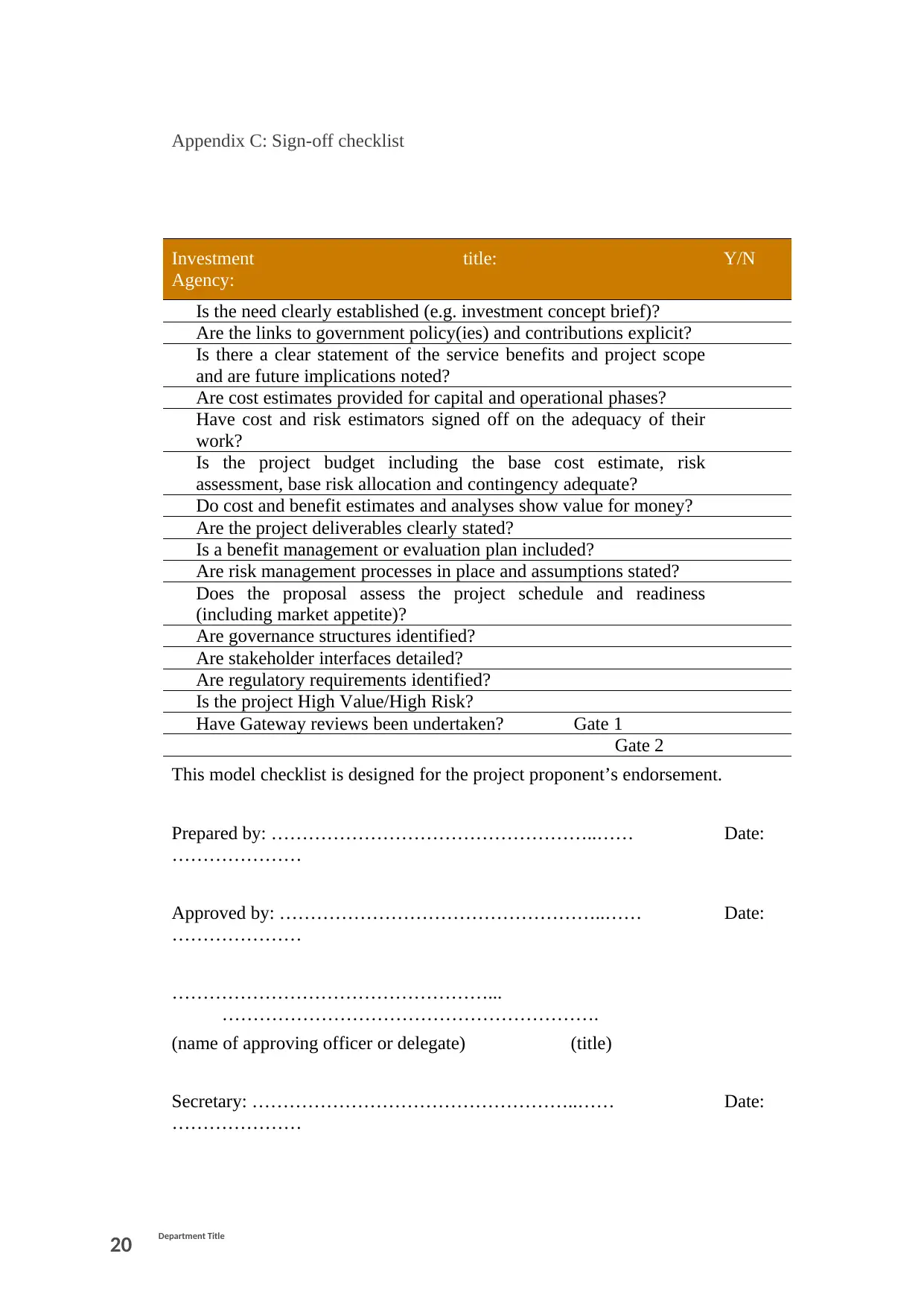
Appendix C: Sign-off checklist
Investment title:
Agency:
Y/N
Is the need clearly established (e.g. investment concept brief)?
Are the links to government policy(ies) and contributions explicit?
Is there a clear statement of the service benefits and project scope
and are future implications noted?
Are cost estimates provided for capital and operational phases?
Have cost and risk estimators signed off on the adequacy of their
work?
Is the project budget including the base cost estimate, risk
assessment, base risk allocation and contingency adequate?
Do cost and benefit estimates and analyses show value for money?
Are the project deliverables clearly stated?
Is a benefit management or evaluation plan included?
Are risk management processes in place and assumptions stated?
Does the proposal assess the project schedule and readiness
(including market appetite)?
Are governance structures identified?
Are stakeholder interfaces detailed?
Are regulatory requirements identified?
Is the project High Value/High Risk?
Have Gateway reviews been undertaken? Gate 1
Gate 2
This model checklist is designed for the project proponent’s endorsement.
Prepared by: ……………………………………………..…… Date:
…………………
Approved by: ……………………………………………..…… Date:
…………………
……………………………………………...
…………………………………………………….
(name of approving officer or delegate) (title)
Secretary: ……………………………………………..…… Date:
…………………
20 Department Title
Investment title:
Agency:
Y/N
Is the need clearly established (e.g. investment concept brief)?
Are the links to government policy(ies) and contributions explicit?
Is there a clear statement of the service benefits and project scope
and are future implications noted?
Are cost estimates provided for capital and operational phases?
Have cost and risk estimators signed off on the adequacy of their
work?
Is the project budget including the base cost estimate, risk
assessment, base risk allocation and contingency adequate?
Do cost and benefit estimates and analyses show value for money?
Are the project deliverables clearly stated?
Is a benefit management or evaluation plan included?
Are risk management processes in place and assumptions stated?
Does the proposal assess the project schedule and readiness
(including market appetite)?
Are governance structures identified?
Are stakeholder interfaces detailed?
Are regulatory requirements identified?
Is the project High Value/High Risk?
Have Gateway reviews been undertaken? Gate 1
Gate 2
This model checklist is designed for the project proponent’s endorsement.
Prepared by: ……………………………………………..…… Date:
…………………
Approved by: ……………………………………………..…… Date:
…………………
……………………………………………...
…………………………………………………….
(name of approving officer or delegate) (title)
Secretary: ……………………………………………..…… Date:
…………………
20 Department Title

References
Blom, M., & Alvesson, M. (2014). Leadership On Demand: Followers as initiators and
inhibitors of managerial leadership. Scandinavian Journal of Management, 30(3), 344-
357.
Bouchard, M. J. (Ed.). (2013). Innovation and the social economy: The Quebec experience.
University of Toronto Press.
Bourne, L. (2016). Stakeholder relationship management: a maturity model for
organisational implementation. Routledge.
Cummings, S., Bridgman, T., & Brown, K. G. (2016). Unfreezing change as three steps:
Rethinking Kurt Lewin’s legacy for change management. human relations, 69(1), 33-
60.a
De Medeiros, J. F., Ribeiro, J. L. D., & Cortimiglia, M. N. (2014). Success factors for
environmentally sustainable product innovation: a systematic literature
review. Journal of Cleaner Production, 65, 76-86.
Du, H. (2013). NFC technology: Today and tomorrow. International Journal of Future
Computer and Communication, 2(4), 351.
Ellison, R. B., Ellison, A. B., Greaves, S. P., & Sampaio, B. (2017). Electronic ticketing
systems as a mechanism for travel behaviour change? Evidence from Sydney’s Opal
card. Transportation Research Part A: Policy and Practice, 99, 80-93.
Gudymenko, I., Sousa, F., & Köpsell, S. (2014, October). A simple and secure e-ticketing
system for intelligent public transportation based on NFC. In Proceedings of the First
International Conference on IoT in Urban Space (pp. 19-24). ICST (Institute for
Computer Sciences, Social-Informatics and Telecommunications Engineering).
Hausman, A., & Johnston, W. J. (2014). The role of innovation in driving the economy:
Lessons from the global financial crisis. Journal of Business Research, 67(1), 2720-
2726.
Kenny, G., & Bourne, M. (2015). Performance measurement. Wiley Encyclopedia of
Management, 1-3.
Kerzner, H., & Kerzner, H. R. (2017). Project management: a systems approach to planning,
scheduling, and controlling. John Wiley & Sons.
O'brien, J. (2015). Category management in purchasing: A strategic approach to maximize
business profitability. Kogan Page Publishers.
Sadgrove, K. (2016). The complete guide to business risk management. Routledge.
Subtitle 21
Blom, M., & Alvesson, M. (2014). Leadership On Demand: Followers as initiators and
inhibitors of managerial leadership. Scandinavian Journal of Management, 30(3), 344-
357.
Bouchard, M. J. (Ed.). (2013). Innovation and the social economy: The Quebec experience.
University of Toronto Press.
Bourne, L. (2016). Stakeholder relationship management: a maturity model for
organisational implementation. Routledge.
Cummings, S., Bridgman, T., & Brown, K. G. (2016). Unfreezing change as three steps:
Rethinking Kurt Lewin’s legacy for change management. human relations, 69(1), 33-
60.a
De Medeiros, J. F., Ribeiro, J. L. D., & Cortimiglia, M. N. (2014). Success factors for
environmentally sustainable product innovation: a systematic literature
review. Journal of Cleaner Production, 65, 76-86.
Du, H. (2013). NFC technology: Today and tomorrow. International Journal of Future
Computer and Communication, 2(4), 351.
Ellison, R. B., Ellison, A. B., Greaves, S. P., & Sampaio, B. (2017). Electronic ticketing
systems as a mechanism for travel behaviour change? Evidence from Sydney’s Opal
card. Transportation Research Part A: Policy and Practice, 99, 80-93.
Gudymenko, I., Sousa, F., & Köpsell, S. (2014, October). A simple and secure e-ticketing
system for intelligent public transportation based on NFC. In Proceedings of the First
International Conference on IoT in Urban Space (pp. 19-24). ICST (Institute for
Computer Sciences, Social-Informatics and Telecommunications Engineering).
Hausman, A., & Johnston, W. J. (2014). The role of innovation in driving the economy:
Lessons from the global financial crisis. Journal of Business Research, 67(1), 2720-
2726.
Kenny, G., & Bourne, M. (2015). Performance measurement. Wiley Encyclopedia of
Management, 1-3.
Kerzner, H., & Kerzner, H. R. (2017). Project management: a systems approach to planning,
scheduling, and controlling. John Wiley & Sons.
O'brien, J. (2015). Category management in purchasing: A strategic approach to maximize
business profitability. Kogan Page Publishers.
Sadgrove, K. (2016). The complete guide to business risk management. Routledge.
Subtitle 21
1 out of 21
Related Documents
Your All-in-One AI-Powered Toolkit for Academic Success.
+13062052269
info@desklib.com
Available 24*7 on WhatsApp / Email
![[object Object]](/_next/static/media/star-bottom.7253800d.svg)
Unlock your academic potential
© 2024 | Zucol Services PVT LTD | All rights reserved.





